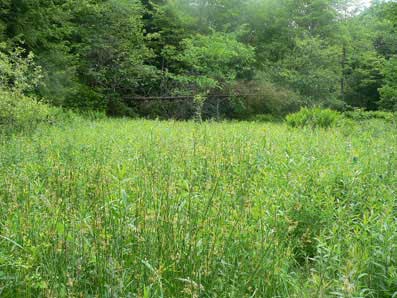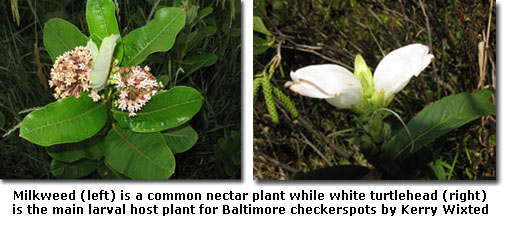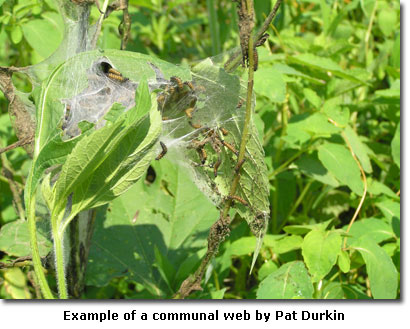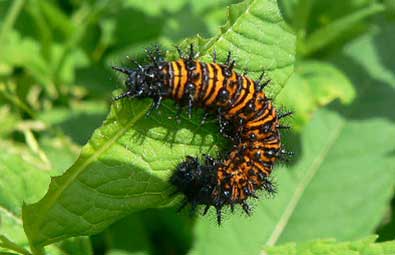Description and Range:
The Baltimore checkerspot is named for George Calvert, the first Lord Baltimore, because its orange and black colors match those on his heraldic shield. In 1973, the Baltimore checkerspot was named the official insect of Maryland.
The Baltimore checkerspot is a medium-sized butterfly in the family Nymphalidae, the brushfooted butterflies, named for their reduced front legs. This trait makes them appear to have four legs instead of six. Baltimore checkerspots have a wingspan of roughly 2.5 inches. Their wings are black in color with white and orange markings. In Maryland, they may be confused with other checkerspots including Harris’s checkerspot and silvery checkerspot, both of which are considerably smaller. New butterfly observers may also confuse them with fritillary butterflies and even monarchs.
The Baltimore checkerspot ranges from Canada south into the eastern United States to the mountains of Virginia and North Carolina and west across the great Lakes Region. Historically, the species’ distribution in Maryland spanned 15 counties, most of which contained multiple breeding colonies. Today, wild colonies are known from approximately 20 sites in 8 counties. Many of these sites are small and isolated. These colonies occur in the western and central portions of Maryland including the Appalachian Plateau, the Blue Ridge, the Ridge and Valley Region and in the Piedmont.

Map of current Baltimore checkerspot locations
Habitat
Baltimore checkerspot colonies are located in early-successional, stream-fed wet meadows with few trees and shrubs. In general, habitats are fairly “weedy” with waist-high herbaceous vegetation including sedges and rushes and few woody plants. The soils in these wet meadows are mostly clay with a pH level of 6.8 or less, making them naturally acidic. The water table (aka water level) varies from the surface to 8-9 inches below the soil; in many wetlands the water table varies throughout the wetland.

Typical Baltimore checkerspot habitat by Jen Selfridge
Diet
Several species of flowering plants provide nectar for adult Baltimore checkerspots. Plants must be blooming during the flight period of the adult butterfly in order to serve as a nectar source. In Maryland, Baltimore checkerspots may obtain nectar from milkweeds (Asclepias spp. L.), especially common milkweed (Asclepias syriaca L.), dogbane (Apocynum spp. L.), several species of mountain mint (Pycnanthemum spp. Michx.) and wild blackberry (Rubus spp. L.).
Baltimore checkerspot caterpillars (larvae) feed almost exclusively on white turtlehead (Chelone glabraL.), especially in the summer when the caterpillars are small. Later in their development when they are much larger, Baltimore checkerspot caterpillars may use a variety of other host plants in addition to turtlehead, including arrowwood viburnum (Viburnum recognitum Fernald), narrow-leaved plantain (Plantago lanceolata L.), penstemon (Penstemon spp. Schmidel) and honeysuckle (Lonicera spp. L.).

Life Cycle
Baltimore checkerspot butterflies have one generation per year. The timing of the Baltimore checkerspot flight period varies regionally, but in Maryland, the flight period generally occurs in June into early July. After mating, female butterflies can lay several hundred eggs on the larval host plant, white turtlehead. Eggs develop over a period of about 20 days and change color from yellow to red. The eggs then hatch into tiny caterpillars (first instar larvae) that begin feeding on white turtlehead. They build a communal web, often at the end of a turtlehead leaf, where they can seek protection from predators and parasitic wasps. As the summer progresses the caterpillars will continue to eat, grow, and molt, developing into second and third instar larvae, which are larger and more conspicuous.

Third instar larvae (caterpillars) will usually stop feeding in mid-August. At this time, they will thicken and compact a section of their web, where they will eventually molt again into fourth instar larvae. They will then enter a state of diapause in which their development is suspended, and they cease to feed or grow. Near the end of October, when the temperatures begin to get cooler, they will move out of the web and into the leaf litter. Soon afterward, groups of caterpillars will roll up in leaves and debris in preparation for the winter months.

Baltimore checkerspot caterpillar by Jen Selfridge
As the weather warms in mid-April, caterpillars will become active and will resume feeding. These caterpillars will not spin webs and will feed independently of one another on the leaves of white turtlehead. If turtlehead is scarce, or if the plants are too small early in the growing season, caterpillars will use alternate species as host plants, including viburnum, English plantain, and penstemon. Once the caterpillars have reached their full size, they will each form a chrysalis (also called a pupa). Within the chrysalis, the caterpillars will begin their transformation into an adult butterfly. For Baltimore checkerspots, this takes about two weeks, after which the adult butterflies emerge, and the cycle repeats.

Baltimore checkerspot chrysalis by Jen Selfridge
Conservation
While the Baltimore checkerspot was once common in the region, the species has experienced significant declines in recent years. Currently, it has a state conservation rank of S2, meaning that it is imperiled in Maryland because it is very rare.
In Maryland, some of the factors that have led to the decline of Baltimore checkerspots include habitat loss and degradation, deer browse on host and nectar plants, and wetland succession. Conservation efforts have mainly focused on monitoring and habitat assessment, protecting land, and encouraging land owners to adopt conservation policies. Maryland's unofficial "Butterfly Conservation Working Group" meets periodically to coordinate research and restoration efforts for this species and other butterflies. Its members are engaged in habitat restoration, coordinated research efforts, education and experimental translocation efforts.
